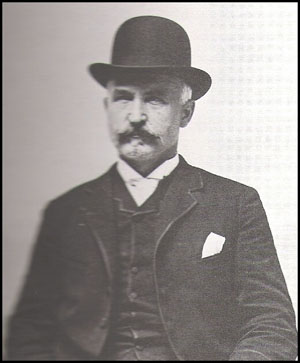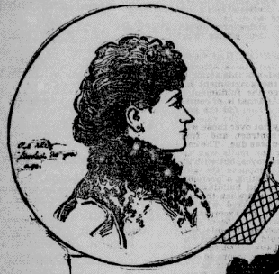Notorious Criminals in the late 1800's and early 1900's
Notorious criminals; these individuals were/are widely known, usually in an unfavorable sense because of their unscrupulous (dishonest, ruthless, unethical, corrupt, crooked, improper, unfair, wicket, dirty, immoral) acts in order to get what they want. And there were many of them in those early days.
Max Shinburn
Maximilliam (Max) Schoenbein (Shinburn), alias Mark Shinburn, alias "Count" Shinburn, alias H.H. Baker, alias M.H.
Zimmerman, alias "The Dutchman," king of bank robbers, master bank, safe and vault burglar.

Maximillian Shinburn (1840-1917)
Photograph, circa 1894
Something of his history
A notorious criminal in the late 1800's was Max Shinburn. He has stolen more, invented more ways of stealing and made
more trouble for the police than anyone else in those days. Shinburn and his partner, George White were master criminals.
Shinburn was a wel educated man who came to America in 1860. It is said when he came to the United States he left his
own country as a fugative. Arriving in New York he associated at once with the leading gamblers. In a short time he became
acquainted with some of the principal criminals. Among these professional criminals whom he engaged with him in subsequent
burglaries from time to time were George Bliss, "Fairy" McGuire, Dave Bartlett, Rory Simms, Billy Maher, Charley
Bullard alias "Piano" Charley, "Big IKe Marsh, Harry Raymond alias Adam Worth, Dave Cummings, Dan Nole, Pete Curley,
"Big Jim" Brady, Sam McCormick, Jesse and Martin Allen, "Big Bill" McDavid, Ed Hughes, Jim McCoy, Tom Kenyon alias
Clark, Sam Perris alias "Wooster Sam" and Ned Lyons, husband of Sophie Lyons.
George Bliss and "Fairy" McGuire used Shinburn in robbing a new Jersey bank. The first bank robbery for Shinburn.
To perfect his knowledge regarding the mechanism of combination locks and safes Shinburn for some time worked under an
assumed name in the works of the Lilly Safe company. Shinburn was one of the best fitters in the burglary line in the United
States. A fitter is one who makes impressions of keys from wax to fit any kind of locks. Anyway, it took him over a year to
obtain all the knowledge he needed for the successful consummation of the series of robberies he had planned. With this
massive valuable information Shinburn and his associates plundered Lilly safes all over the country, finally driving the Lilly
company out of business. Shinburn made fortunes during 1860 and 1869 when he was obliged to flee from the United States.
Some of the banks robbed by Shinburn from 1860 - 1869:
The New Windsor Bank, of Maryland.
A bank at Binghampton, Vermont.
During 1864 he had secured a handsome sum of money from several banks in New England.
He robbed the Concord (New Hampshire) Bank. He was captured, tried, convicted and sentenced to the Concord State
prison for 10 years. He escaped and rearrested 12 months later. Again he escaped.
He engaged in the robbery of the vault in the office of the Lehigh and Wilkesbarre Coal Company in 1868. This company was
a client of the Pinkerton Detective Agency and the matter was placed in the hands of G.H.Bangs, general superintendent of
the agency. He succeeded in arresting Shinburn as he left a saloon in Broadway. During the night Shinburn escaped.
The Walpole Savings Bank , at Walpole, N.H.
Shinburn was arrested for the Walpole Bank robbery, was convicted and sentenced to 15 years imprisonment. He escaped.
This was in 1869. He made the final trip from Wikesbarre to New York and shortly afterwards was arrested by Allen Pinkerton
and G.H. Bangs. But he escaped the same night he was turned over to the county officials by picking the lock. The next heard
of him was in '69, when with others attempted to rob the St. Albans' Bank Vt, Franklin county. The watchman surprised the
burglars in the bank, opened fire on them and they fled. Shinburn was arrested. After serving 9 months of his 10 year sentence
by the aid of a friend, who bored holes in the gate of the Concord penitentiary and he was then able to crawl out in the face of
the guards and the prison gang.
He robbed a bank at Cadiz, Ohio.
He robbed the Ocean Street Bank in New York (June 1869), Shinburn when caught turned the spoil over to a detective, who
allowed to him to escape. The detective was later dismissed from the force.
Shinburn then robbed the West Maryland Bank. Was arrested in New York and again escaped. Scores of banks were robbed
by him, including many in New England.
The greatest crime of Shinburn and his partner George White was the theft of $2,550,000 from the Ocean National Bank of
New York
Shinburn escaped to Europe and settled in Belgium
It is said he left the United States with nearly $1,000,000. He went to Belgium where he lived in Brussels for many years.
He bought a large estate, started in manufacturing there and made money fast. Shinburn, a "Count" - While there he purchased
the title of Baron Shindle and was known in Brussels by that name. He attended to his business, and enjoyed his fortune, but
eventually his passion for gambling got the best of him, and loosing his fortune, he went back to burglarly again. He then joined
some of his old friends in Paris. Charley Bullard was among them. The robbery of the Provincial Bank at Verviers followed in
1883. They were captured in the bank.
Shinburn was sent to jail for 5 years, some say 10 years, others say he escaped in a month.
Robert Pinkerton had information that after Shinburn was released from Jail in Belgium he had gone to England, and,
communicating with their agents (corps of detectives, and several operatives connected with Pinkerton's detective agency) in
England, learned that Shinburn left England, and it was supposed had gone to America. The country was startled from time to
time after his arrival by the robbery of country banks in all sections of the country.
The hunt for Shinburn has been going on for over a month and they only succeeded in locating his house. A careful watch was
placed on it. Then came the robbery of the First National Bank at Middleburgh, N.Y. A thorough investigation showed that the
men concerned in the robbery were Jack Reynolds, alias William H. Brown, alias John A. Ryder, alias William Haywood, who
was arrested at Schenectady immediately after the robbey took place; Max Shinburn, William Maher, William Kelly and
another burglar. A diligent search was then kept up for Shinburn and the other men. He was arrested on June 29, 1895 by
Pinkerton detectives under detective Butler at Thirty-fifth street and Seventh avenue, New York City, on the charge of robbing
the First National Bank of Middleburgh, N. Y., in February. Burglar tools, drills of all kinds, skeleton keys, lock pics, pistols,
a bottle of nitro glycerine, and everything pertaining to a burglar's outfit were captured.
On May 22, 1896 he was sentenced to 4 years and 8 months in Dannemora for the Middelburgh robbery. He was released
from Plattsburg on October 10, 1900, but was immediately rearrested by sheriff W.S. Tuttle, of Keene, N.H., who had
requisition papers from the governor of New-Hampshire. Present was J.W. Rogers, a detective for the American Bankers
Association, which had been waging war on Shinburn for 40 years.
After serving almost 8 years in prison Shinburn walked out of the Concord, N.H. penitentiary a free man. April 1908.
Who was the Pinkertons?
W.A. Pinkerton was head of the western division of the Pinkerton National Detective Agency, with his nephew, Allen Pinkerton, who was the son of Robert Pinkerton, head of the eastern division of the agency. The American Bankers Association had employed Pinkerton to hunt up Shinburn and the arrest was an outcome of a dilligent search paid for by the bankers.
Sophie Lyons, the notorious woman thief

Sophie Lyons (1850-1924)
A criminal by heredity. Her grandfather, her father (Sam Levy, was a house breaker of eminence) and her mother (was a shoplifter of skill)
were thieves of note, also her husband (Ned Lyons, an all round crook and associate of Max Shinburn - he robbed
many banks) and her son ( He died in Auburn prison). She had two daughters. They were nuns in a Montreal convent.
The police said that she could not resist the temptation to steal; that the craft was born in her and that its fascinations were
stronger than her will. When she was a child, living on the east side of town, she was a pickpocket. She mingled with thieves
of all shades. She was picking pockets before she was 10 years old. She was later described as the cleverest pickpocket
the world over. Her skill was so marvelous that it seemed akin to the work of magicians. Her righthand, the hand that
accomplished these wonders was long, slender and as pliable as a professional pianist's. The fingers tapered beautifully, but
they could bend and twist like pieces of rubber. How many pockets they have slipped into during her time will never be known.
Other notorious women criminals
Sophie Jerome was famous female criminal.She hoodwinged bankers and financial men of all decrees.
Alice Hall one of England's notorious women criminals.